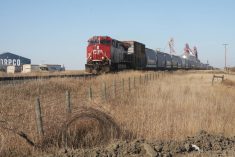WHEN driving into a storm, it seems like a good idea to pack a shovel. After all, one should have a shovel ready.
But as of the beginning of April, I was rather hoping we could all forget about being shovel ready for a season or two. No such luck.
In the face of the economic storm we’re facing, it seems that being shovel ready has never been more important.
The recent federal budget, with its large economic stimulus package, puts an urgent priority on shovel readiness. Men who have never worked with shovels themselves are so excited about shovel ready projects that billions of public dollars have been allocated to ensure that they get underway immediately.
Read Also

Crop insurance’s ability to help producers has its limitations
Farmers enrolled in crop insurance can do just as well financially when they have a horrible crop or no crop at all, compared to when they have a below average crop
The Economic Action Plan slates $12 billion over the next two years for infrastructure construction. Job creation is so urgent that the first $3 billion will already be spent this spring on projects that can be started immediately.
These projects will even be exempted from the normal federal environmental assessments and some other rules to speed things up.
Good physical infrastructure is certainly part of a strong and lasting economy. But so is a clean environment. Taking a shortcut on environmental assessments is taking a detour into future trouble.
The sudden popularity of shovel ready projects stems from the view that the best and quickest way to create jobs and stave off further economic decline is to fund construction projects. Already planned infrastructure projects such as roads, bridges, houses and other buildings fit the bill. Useful and ready to go.
It is understood that most of these construction jobs will be male jobs.
But job losses are not only affecting male workers. A large majority of women in Canada are in the paid workforce. For example, more than two-thirds of mothers with children under the age of five are working outside the home. And many farm families depend on the off-farm jobs of the women partners.
When I asked the participants at an International Women’s Day celebration last month whether they could think of any projects in their communities that would create jobs, be useful and were ready to go, the response was enthusiastic.
The rural and aboriginal women in the room suggested a range of projects that would clearly meet those criteria. They included child care and early childhood learning centres, improved school programs, education, training and other social investments.
They focused on investing in people, as well as in physical infrastructure. As the children and grandchildren will inherit the debt, it’s only fair that they be included in the spending priorities.
Furthermore, the future economy depends on their ability to fix the problems they are inheriting. Investing in them is not only just. It is also prudent.
The real purpose of all this publicly funded economic stimulus must remain clear. The economy should serve people well, not the other way around.
Investing in people, especially children, is investing in a moral economy and a better future.
Nettie Wiebe is a farmer in the Delisle, Sask., region and a professor of Church and Society at St. Andrews College in Saskatoon.
















